No products in the cart.
Pieces of World
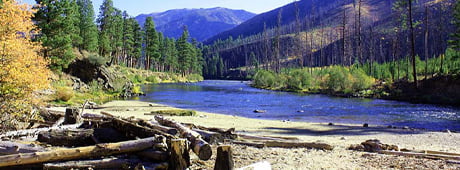
What Belongs Where?
By Paul Lindholdt
I stepped away from breaking camp on the Salmon River, stowing dry bags in rafts, and did a sweep of our sandbar before strapping on my flotation device. This site appears on no maps, and its swift-water approach had made landing a challenge the previous day.
The large bar harbored native bunchgrass and willows that the next high water might wash out. Downstream the sandbar narrowed and ended where a slide of talus fell away to the shore. There a flat granite boulder, chevron-shaped, held a benchmark set by the Geodetic Survey in 1945.
Our purpose for this trip down the river was to help restore its ecosystem. Eight of us sandaled paddlers had teamed with three in the U.S. Forest Service to travel eighty miles through the heart of the largest designated wild area in the Lower 48, the Frank Church–River of No Return Wilderness.
Guided by two patrol rangers and a range conservationist, all from the Slate Creek Ranger Station in northern Idaho, we were helping to slow the spread of spotted knapweed, Centaurea stoebe.
After its introduction to Montana in a load of crop seed, the invasive thistle from Eastern Europe has overtaken millions of acres in the West. Knapweed, like other alien invaders, practices allelopathy: it poisons the soil, generating chemistry suitable only to itself. It stuns competing greenery.
Every stalk of knapweed also disperses a thousand seeds that remain viable in soil for five years. Those seeds travel by hitching rides downstream.
Noxious and exotic weeds can prove beautiful, but dozens of alien invaders suggest the Idaho high desert is a biological island akin to Hawaii: an isolated niche, landlocked by big water, an ecosystem vulnerable to plunder.
Many alien invaders, like the now-endemic Norway rats that throng America’s coastlines, got their start by stowing away on waterborne cargo. Rapid globalization today means native species everywhere face greater risks.
At our swift-water camp, several of us had gotten chills from native spiders creeping around, big buggers that sheltered in a bed of stones near our tables and stove. One dashed in front of me now, pursued by a long-legged wasp, also a native. The wasp flew at the spider, which flipped on its back to fend off the assault, all eight legs in the air, then righted itself once more and whirled away like a spinning coin.
Still the wasp pursued it, agile and fast. Numb, I wondered what I was witnessing. Nest protection, territorial display, a mortal match between predator and prey?
The wasp is common, and I had seen its kind before—flicking wings, hopping on long legs, breaking into short explosive flights, twitching always for prey. Many species of wasps share Earth’s thin crust with us and mostly go unnoticed, but this one looked menacing, in a vaguely sexual way. It pinned the spider, bent at the waist, flexed and probed with its stinger to drive home the stunning stroke.
Again the frantic spider fled. A few more tumbles and sprints, and the flying insect got its way, paralyzing its prey with a protein cocktail. Only then did it lie atop the spider and rest, appearing out of breath.
It was a female spider wasp, one of forty-two hundred species worldwide, three hundred in North America—a solitary wasp, as distinct from social wasps like yellow jackets and hornets. Only the females pursue the spiders. Only they do the stinging, using a modified ovipositor or egg-depositing organ.
Other solitary wasps work their predatory juju on crickets, grasshoppers, caterpillars, cicadas, even tarantulas. The tarantula hawk wasp engages in battles that can last hours. Female cicada killers paralyze their prey, straddle it, grasp it, and fly it to their nests.
If my spider wasp followed form, it would clip the spider’s legs, tote the immobile body to a cell, and then lay and attach a single egg. Clipping the legs is meant to prevent the spider’s escaping – if it manages to survive the sting – from the cell made of wood chips chewed and extruded, or from mud gathered up and daubed to dry.
Once the egg has hatched, the legless spider serves as living nutriment for the larva. The spider wasp’s offspring likes living flesh, still fresh. After it has fed, the larva pupates in a silky thin cocoon.
I chose not to wait and watch the wasp make nursery preparations that day. My companions in the rafts were waiting for me, and I had to go.
* * *
A bar at Marble Creek on the Salmon River. Rex Parker.
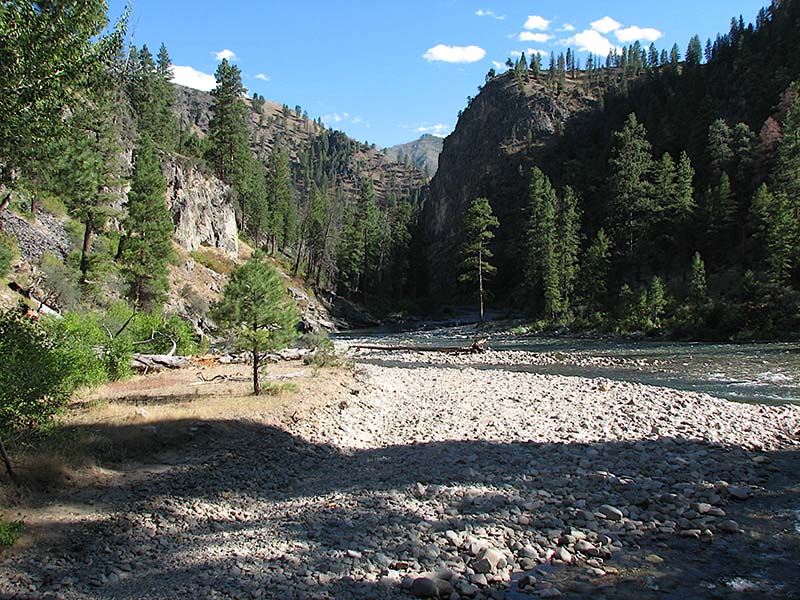
Gathering weeds on the river. Courtesy Paul Lindholdt.
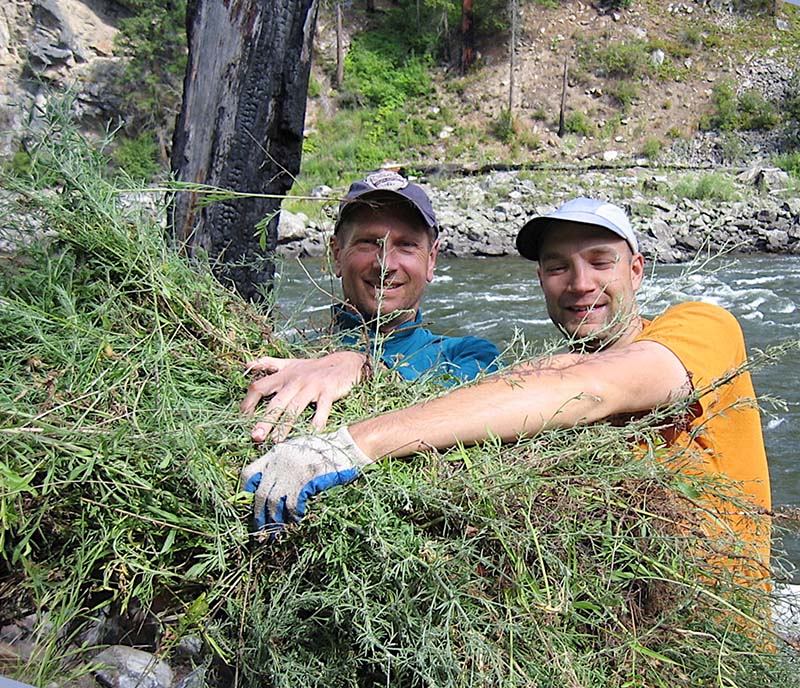
Don Jeffery. Photo by Paul Lindholdt.
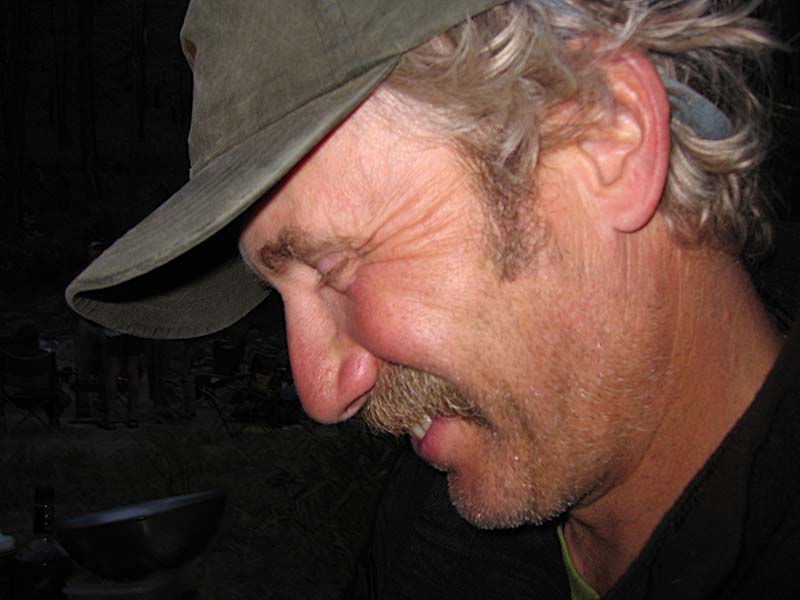
Howard Lyman. Photo by Paul Lindholdt.
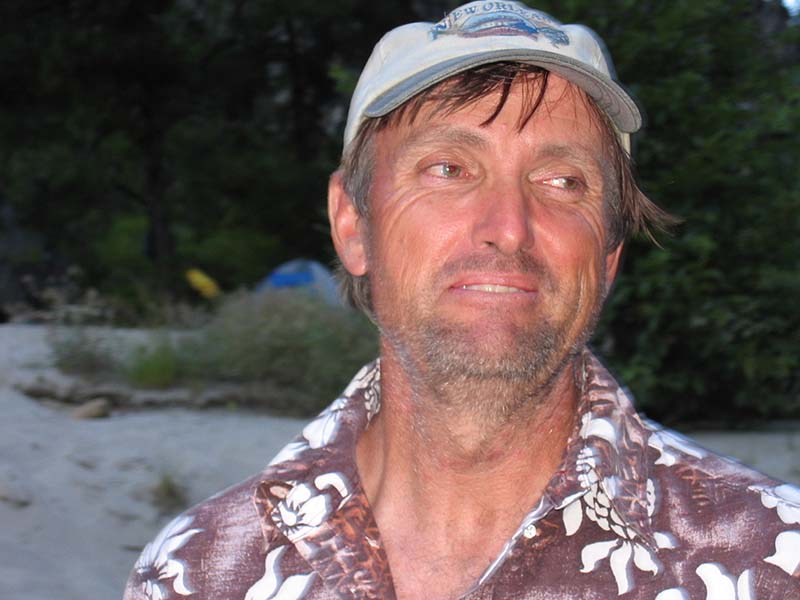
Indian Creek launch site on the river. USFS.
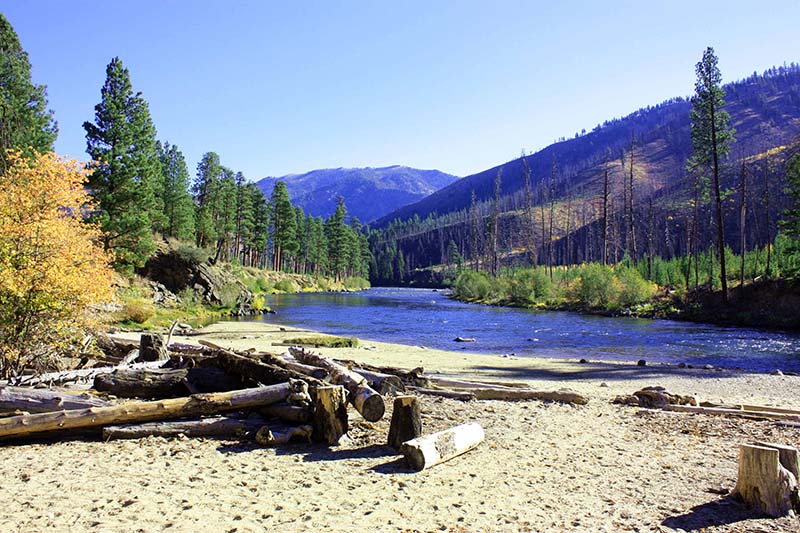
Linda Hagedorn. Photo by Paul Lindholdt.
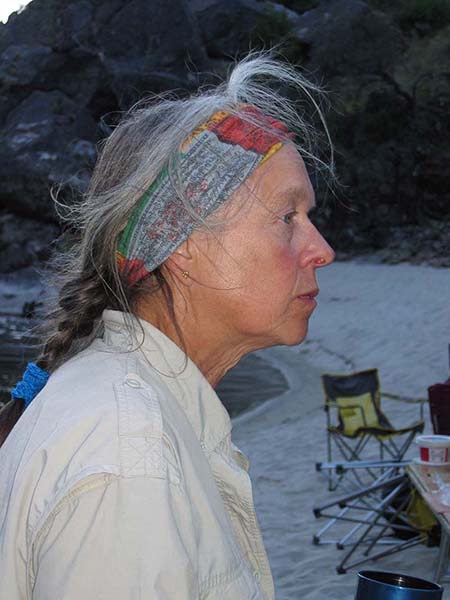
When seasonal ranger Linda Hagedorn rowed on big water, she always faced downstream to navigate the rapids and turns. Unless the wind gets stiff or the current slack, oar-rig captains shove the arms of the oars to steer the craft. Manipulating the overlong oars by skill instead of force, partnering with the current instead of gouging against it, Linda made it look easy to end a habit of rowing with the back instead of arms.
Linda and Don Jeffery, the other seasonal ranger, guided and outfitted us. This river-savvy pair, former commercial guides, became our safety teachers. On big oar rigs they hauled the food and gear, stowing and rowing with grace and skill. Range conservationist Howard Lyman, a Forest Service lifer, knew the invasive plants and what it takes to knock them out, and so he toted several tanks of herbicides along.
The seven other passengers and I were volunteers, not clients. We had signed release forms and were working right alongside the tested veterans. We needed to be quick studies, remain on task, never stray from our duties. Our job was to pull knapweed by hand, extract it with trowels where we must, and help to “naturalize” the sites.
Forest Service policy required our guides to dismantle fire rings, toss rocks into deep water, scatter charred wood remains, and create the illusion of virgin camps. That is what it means to naturalize a campsite. The Wilderness Act of 1964 specifies that wilderness must be a place “untrammeled by man.”
Ranchers and farmers let knapweed escape on public lands, but to let the thistle have its way in The Frank would be to allow our species to trammel that ecosystem badly. We are “only visitors” within official wilderness, the act says.
At the end of each day, after responsibilities fell away, we volunteers could loosen up with our guides.
“Why are you a vegetarian?” I asked Linda.
Reasons people eschew meat are many. She aimed a glance toward Howard, the range conservationist, the grasslands specialist, the cattlemen’s liaison with government agencies. Howard had done the shopping and laid in meals of steaks, chops, sausage, and bacon.
“I’m an animal person,” Linda whispered, an admission that has become code in certain circles for animal-rights activist or sympathizer. For us other meatless eaters, she had stocked soy burgers.
The second Forest Service seasonal ranger, Don, has graying curly blonde hair, lapping over the ears and balding in the front, set off by a cowboy mustache. His cheeks are healthy red. When he grins the front teeth buck, the cheeks plum, and the blue eyes crinkle and squint.
Stubby and cherubic, he has never married. In moments of most contentedness, sunning on a raft or dripping dry after a dip, he curls in upon himself, an image of blissful enclosure.
Don attended Boise State University and the University of Idaho, earning a degree in recreation. In the winter he ski-bums at Brundage and Bogus Basin, selling gear part-time at an equipment shop in Boise. A diehard Idaho native, he ran a bicycle shop in Moscow and another in mountainous McCall, between gigs as a guide on the Middle Fork of the Salmon River. Following fifteen years of experience as a river rat, he joined the Forest Service as a seasonal employee.
At one site, Howard used a sweep net to gather beetles where he’d released them to feed on knapweed. He planned to release them again on Yellow Pine Bar, a steep hillside above the river. “Too early to say if they’ll work,” he admitted. Those beetles are part of a bio-control program, an integrated pest management plan.
Howard wears the pinched look of a religious ascetic, though he seems to believe in little besides hunting chukars and spraying weeds. I tried to draw him out, but it proved hard, even when I regaled him with tales of my youth misspent inventing varieties of fun with guns. He has a slow oral delivery, a flat affect.
A man of few words, his face is berry brown from outdoor work, and his legs thin. He raises and trains yellow Labrador retrievers and sells them to other hunters.
After a couple of days on the river, Howard came to believe my interest in weeds and grasses was sincere. He strolled into our camp at Big Mallard Creek with “three good bunchgrasses,” and we sat down on luxuriant folding chairs.
“This here’s prairie junegrass, Idaho fescue, and bluebunch wheatgrass.” Those three grasses are the gold standard for nutrition, the flora profiled in the classic western films. Against them, dozens of alien plants come to be judged. I reached out to stroke their wispy heads, so fragile by contrast with the spiny, seedy, forceful knapweed.
When I prompted him, Howard reeled off the genus and species of all three grasses, though the scientific name for the wheatgrass species cost him a thoughtful pause. At last he shook his head. “The dang taxonomists changed the name, but I just can’t change.” He cradled the grasses as a lover might.
Fescue leaves are rolled or “involuted,” he pointed out, not flat like the others. All three grasses “interchange in their dominance, depending on the moisture.” The bluebunch grows on drier sites or “xeric” sites, while the fescue prefers the wetter “mesic” sites, mostly north facing and “hard to locate hereabouts.”
As a “range con” or conservationist, Howard mediates between agencies and private growers of beef—mostly grandee ranchers who benefit from federal largess on public lands. He knows what cattle thrive on, and “it ain’t weeds.” And so the Bureau of Land Management and the Forest Service shoulder all the weight of keeping ranges free of weeds, varmints, and discouraging words alike.
An uncomfortable analogy had been agitating me: that weeds are to public rangelands what Asians or Mexicans (name your human “invasive”) are to U.S. urban areas. The analogy discomfits for several reasons, but mostly because managing knapweed might incite comparisons to nativism, or worse, to fascism.
We academic scholars tend to be teapots that brew up little tempests, and the heady beverages we blend are ecological philosophies. Slurs, stereotypes, and damnations are entering public-policy discourse on the weeds. Lands managers revile them, ecologists too. The fear of nativism reared up for me this past year when someone confessed he had fled the Bay area’s “Asian invasion.”
Howard shared an analogy that soothed my discomfort. Weeds succeed, he said, like manufacturers that enjoy cheap labor and little or no competition in markets abroad. His analogy made sense, but I had to chew on it awhile.
Big-box stores often effect predatory pricing via foreign labor, and U.S. corporations, when they head overseas, manufacture needs in naïve buyers abroad. The U.S. softwood industry suffers from cheap exports out of Canada, exports that can trigger market gluts and World Trade Organization hearings.
If native predators offer ecological competition to species they have coevolved with—like the wasp that stunned the running spider—then predators of knapweed have yet to evolve in America, and therefore Howard’s spraying and our handpicking became the Salmon River equivalents of trade tariffs.
* * *
It was suppertime on the river. Our barbecued salmon was ready to eat, the sun sliding behind a high hill, and two hours remained until dark. Falcons whipped everywhere, birds of godly grandeur, currents of high air made flesh. Their bent-wing silhouettes gave them away.
A pair of prairie falcons flew one above the other, the higher bird bearing a morsel, half a ground squirrel maybe. As if the exchange were timed, the top bird dropped the food and its mate swiveled upside down to catch it without a wobble.
I was looking forward to a good night’s rest. How easy it always is for me to sleep deeply out of doors. It feels safer, the air cleaner, anywhere that walls do not enclose. Outdoors I sleep deeply and dream vividly, and on our third night alongside the river I dreamed of weeds.
I had been reading one of Howard’s field guides, and what struck me was not the sheer abundance of weedy species, or their skill in dominating pristine landscapes, but their names.
What a rich book could be written about western weeds, including perhaps the forbs! One can find not only prostrate pigweed, bur chervil, spiny sowthistle, blessed milkthistle, tansy ragwort, and poverty sumpweed. Plants like these can make geographies painful and poor, as their names suggest. Next come spikeweed, hawkweed, skeletonweed, gumweed, nodding beggarticks, sagewort, wormwood, and ragweed: names dabbed on so thickly they welt the throat and tongue.
I also found curlycup, cudweed, crupina, hawksbeard, horseweed, fleabane, bull thistle, rabbitbrush—vegetative epithets, insults, imprecations escorted by snorts. It was not much easier to like distaff thistle, black henbane, buffaloburr, toadflax, musk thistle, and land caltrop.
Nature’s creations have inspired some gruff implements of war, as when warriors armed forts with abattis, barriers of trees whose branches they might sharpen or entwine with wire. Knapweed is fortified already. Some plants have useful leaves and thorns and yet pose linguistic threats, such as skeleton-leaf bursage, toothed spurge, star thistle, and puncture vine.
When a man by the name of George de Mestral came home from a walk one day and found his dog covered in burrs, he looked at the embedded hooks beneath his microscope, and then invented Velcro™.
A science photographer, Jon Triffo, once found a spider wasp nest and cracked its sealed chambers. They contained five entombed arachnids, two young and three adults. The young spiders were entirely intact, either in a toxic coma or dead—the wasp’s strong neurotoxin had done them in.
“The adults were entirely legless, and either partly paralysed or not paralysed at all,” Triffo wrote. The legs, he noted, had been cut off with “remarkable mini-surgical precision.” He shuddered, as most of us would do, when the adults began to move.
All five spiders had single eggs attached to them, eggs that soon would hatch. The adult spiders were partly mobile, “able to pull themselves awkwardly forward along flat surfaces with their pedipalps.” From Latin, pedipalps are mouthparts that male spiders charge with sperm to inseminate the females. Triffo’s spiders were hauling themselves by the equivalent of penises.
“Eerily even more so,” Triffo continued, “their long chelicerae [or jaws], each gruesomely tipped with wine-colored, curving fangs, were functional. The hapless yet defensive little beasts actually presented me with spine-chilling threat displays, such as they could, with their ‘moving parts’.”
Triffo’s story, which took strength for me to read, narrated his close-up photos. Such moving prose, composed by one trained in the sciences, worked its sympathetic magic on me.
Ever since Aristophanes wrote in fifth-century Greece, parasitism has invited symbolic readings. For allegorical minds, the larva may resemble sickness or gnawing sin. But to yield to such readings is to allow that the world is made chiefly for our species, a disturbing thought.
Spiders and wasps are pieces of world we’re not responsible for. Knapweed, though, is our responsibility. We both introduced it and need now to curtail it.
One night along the river, after I woke from a good night’s sleep unafflicted by dreams of spiders or wasps, I discovered that it was the old world yet, the world I cherish. I was still myself, though my things were wet. Heavy dew had fallen that night, but soon enough all would dry in the sun.
If you enjoyed this story, please consider supporting us with a SUBSCRIPTION to our print edition, delivered monthly to your doorstep.
This content is available for purchase. Please select from available options.
Purchase Only
Purchase Only

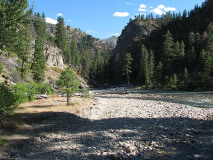
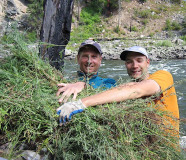
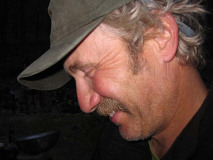
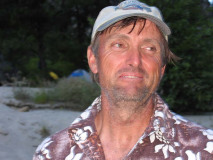
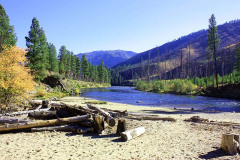
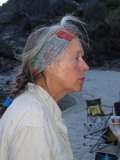

2 Responses to Pieces of World
Barry Burnett -
at
This doesn’t read like most non-fiction. So well-written!
Mike McGarvey -
at
A very enjoyable read, John. Thanks for the education and the trip. I’m familiar with knapweed. My brother owned property between Spirit Lake and Athol that was covered with it. it was a real fire hazard in the late Summer and early Fall.